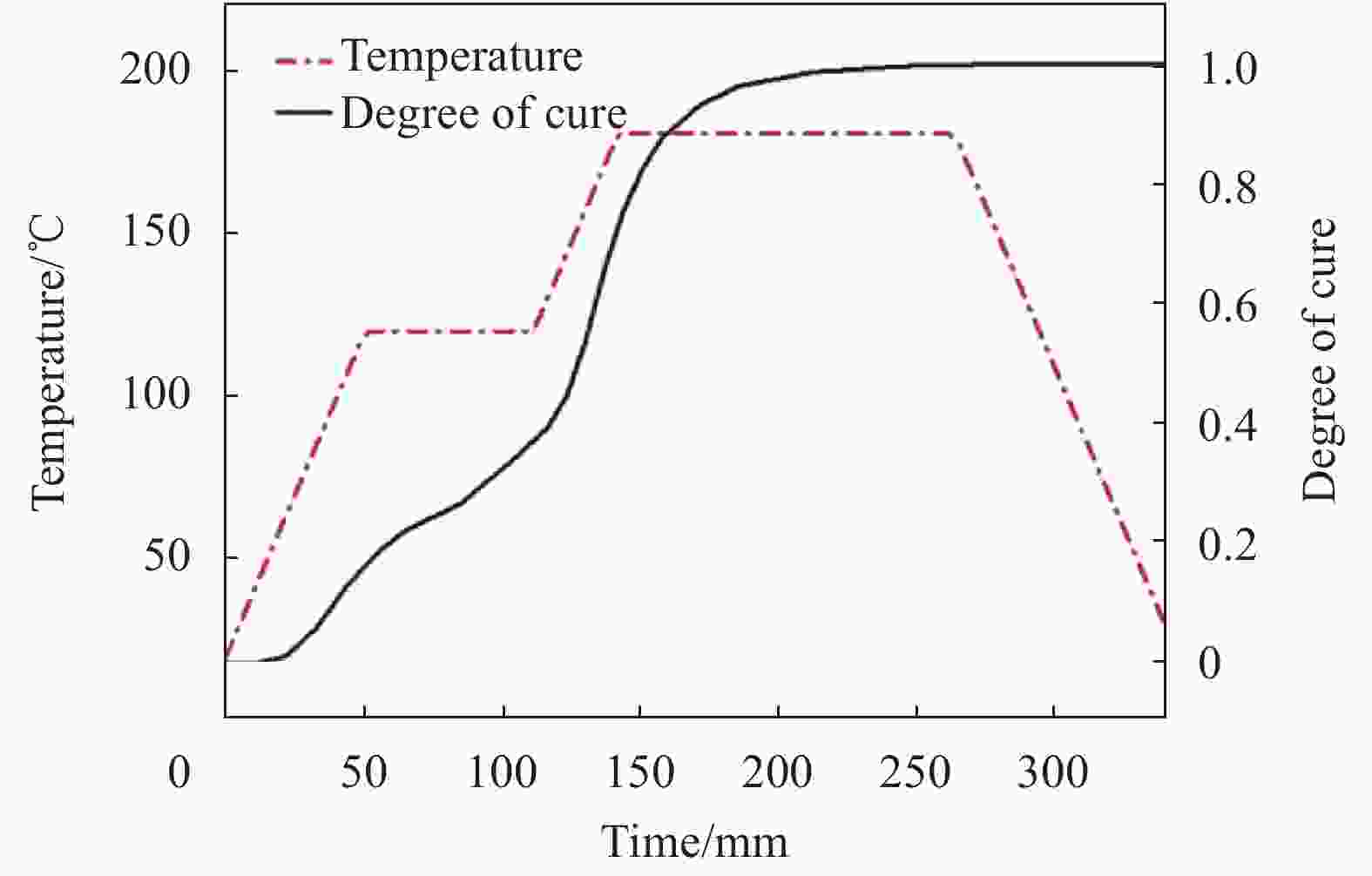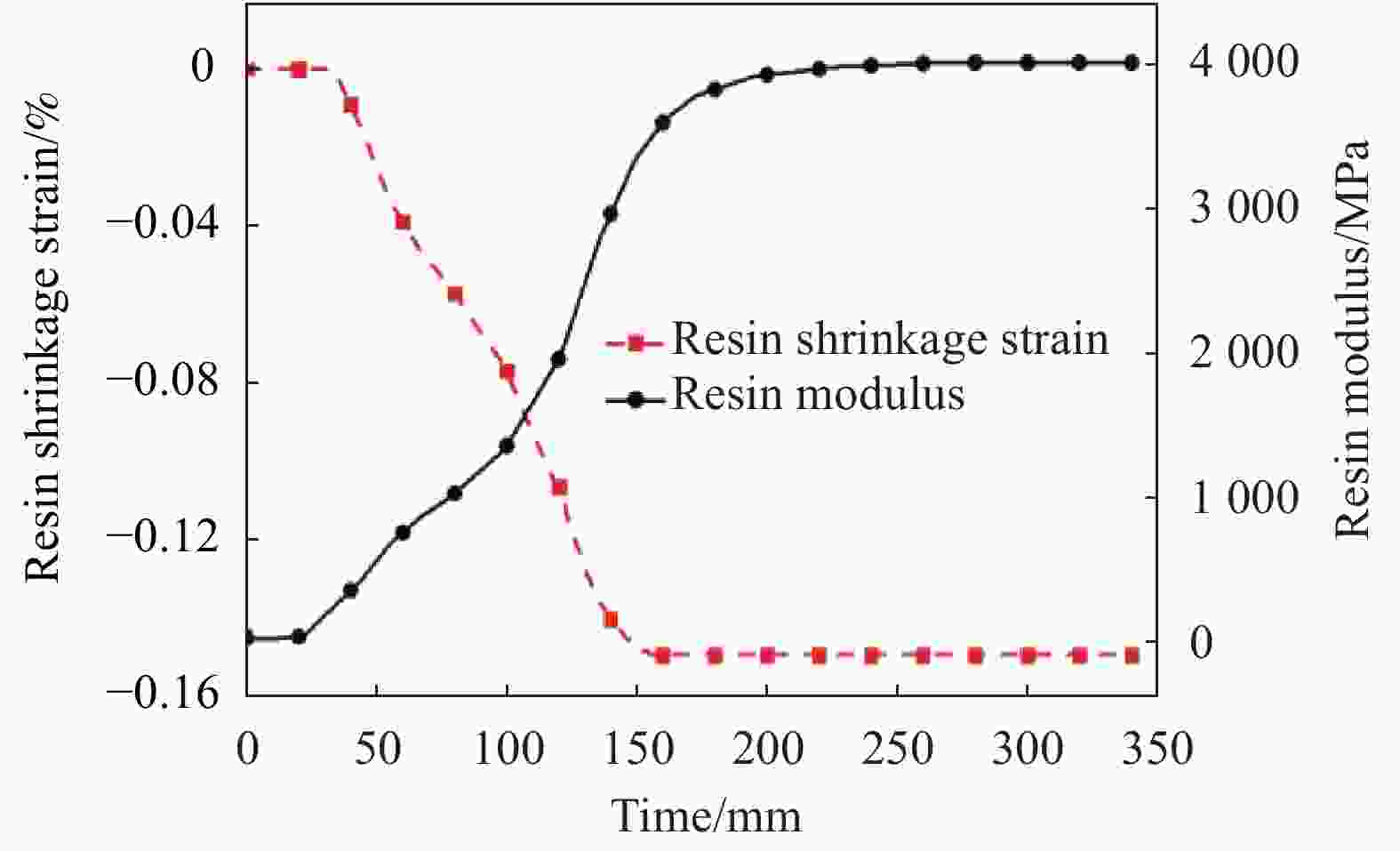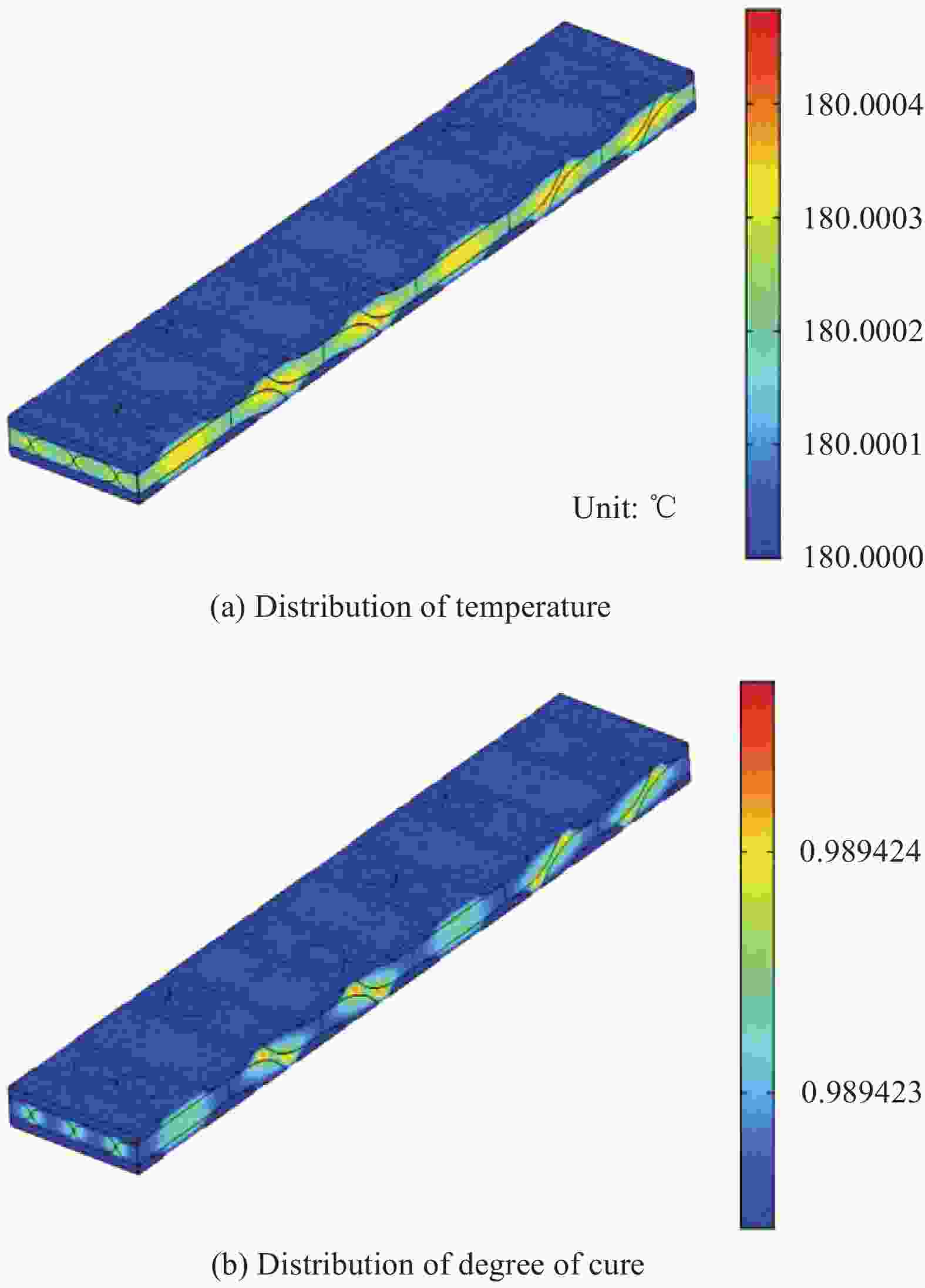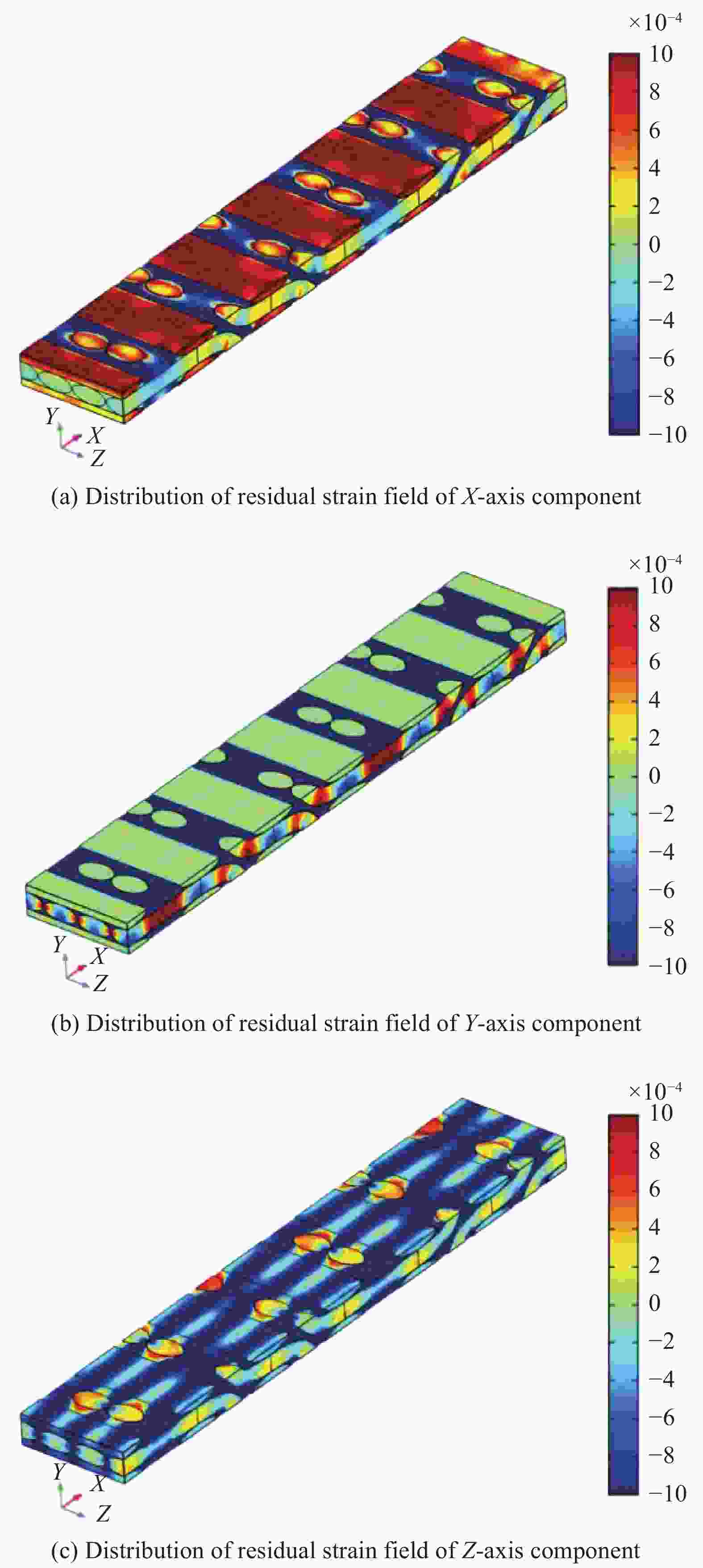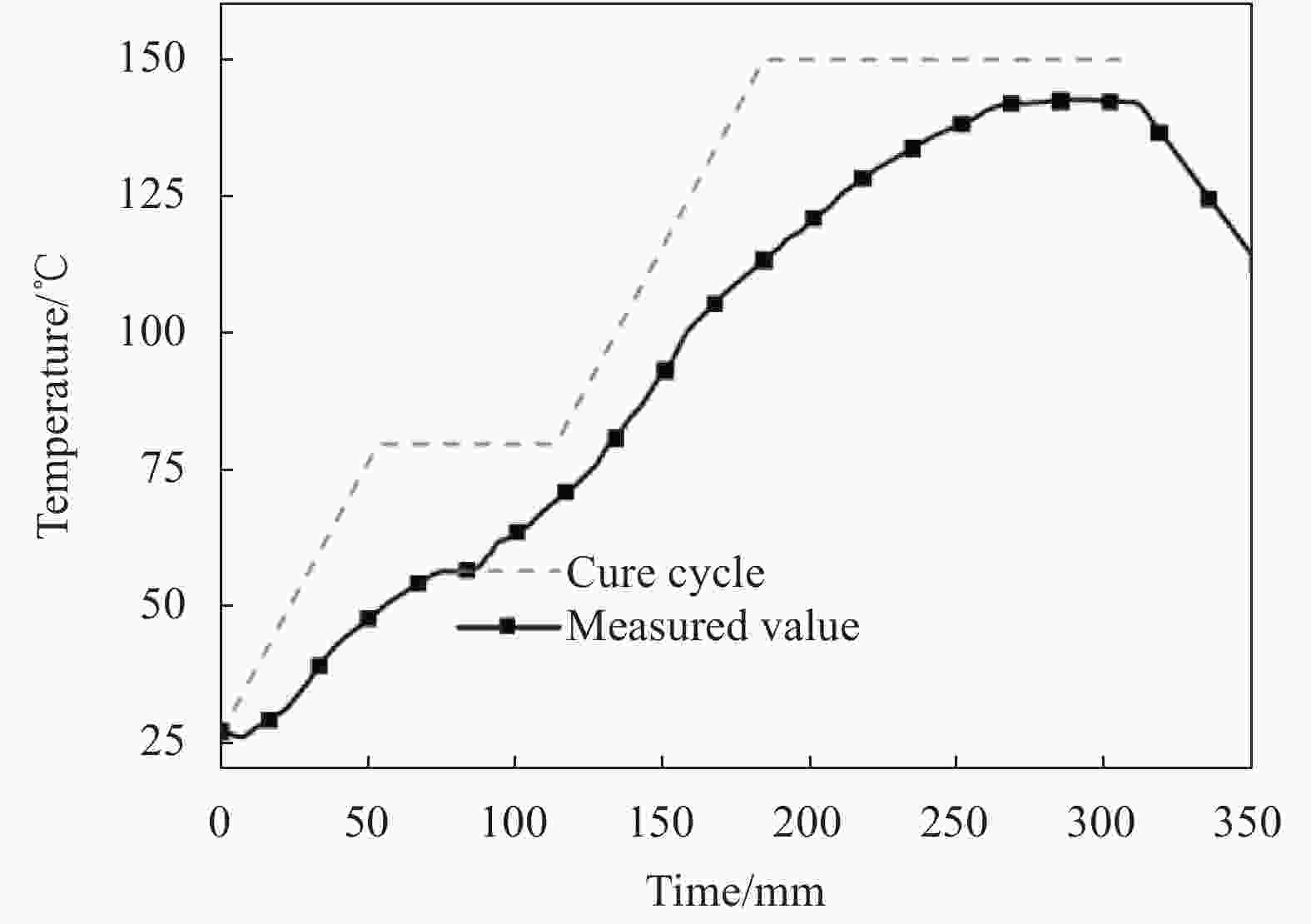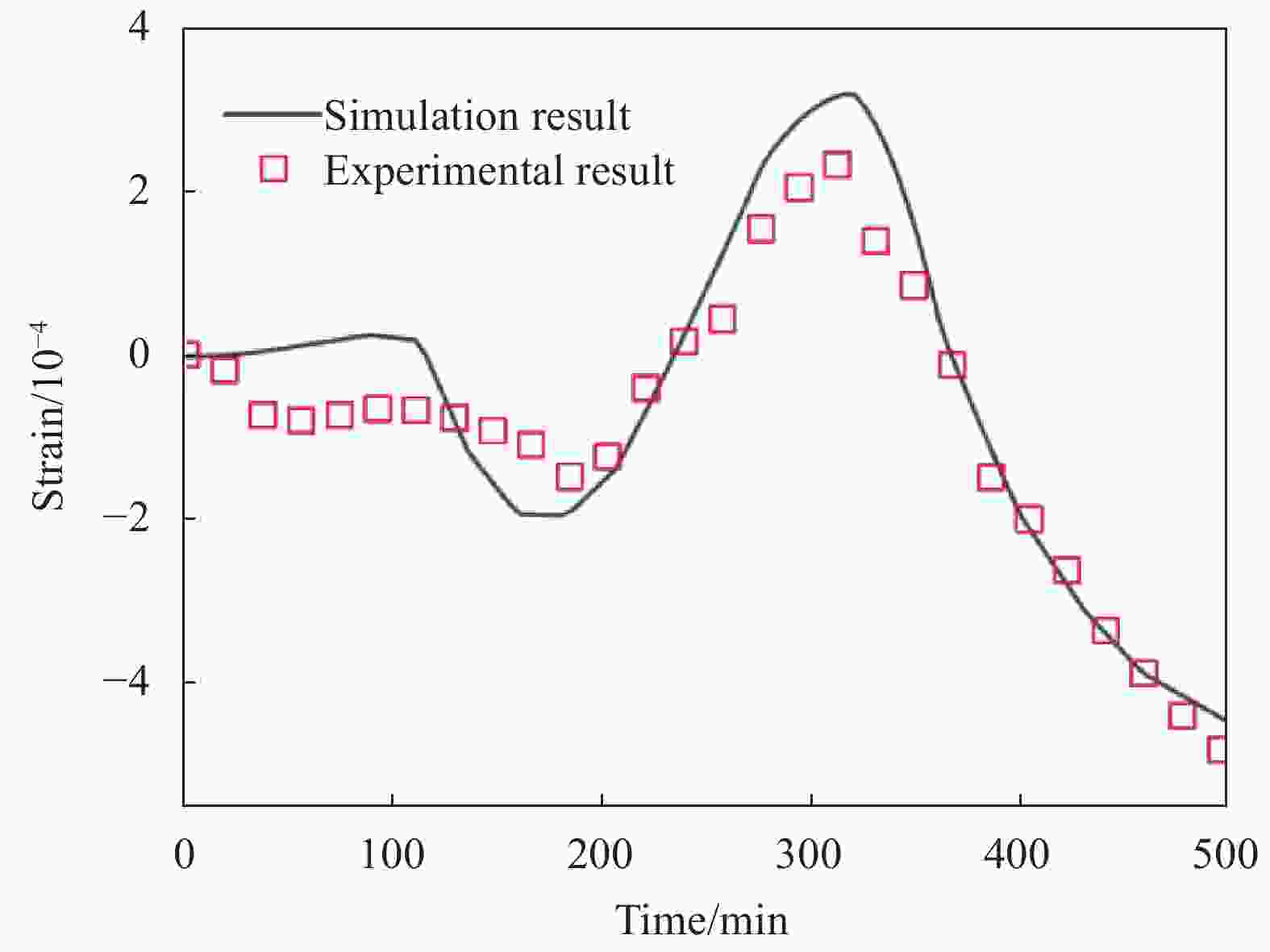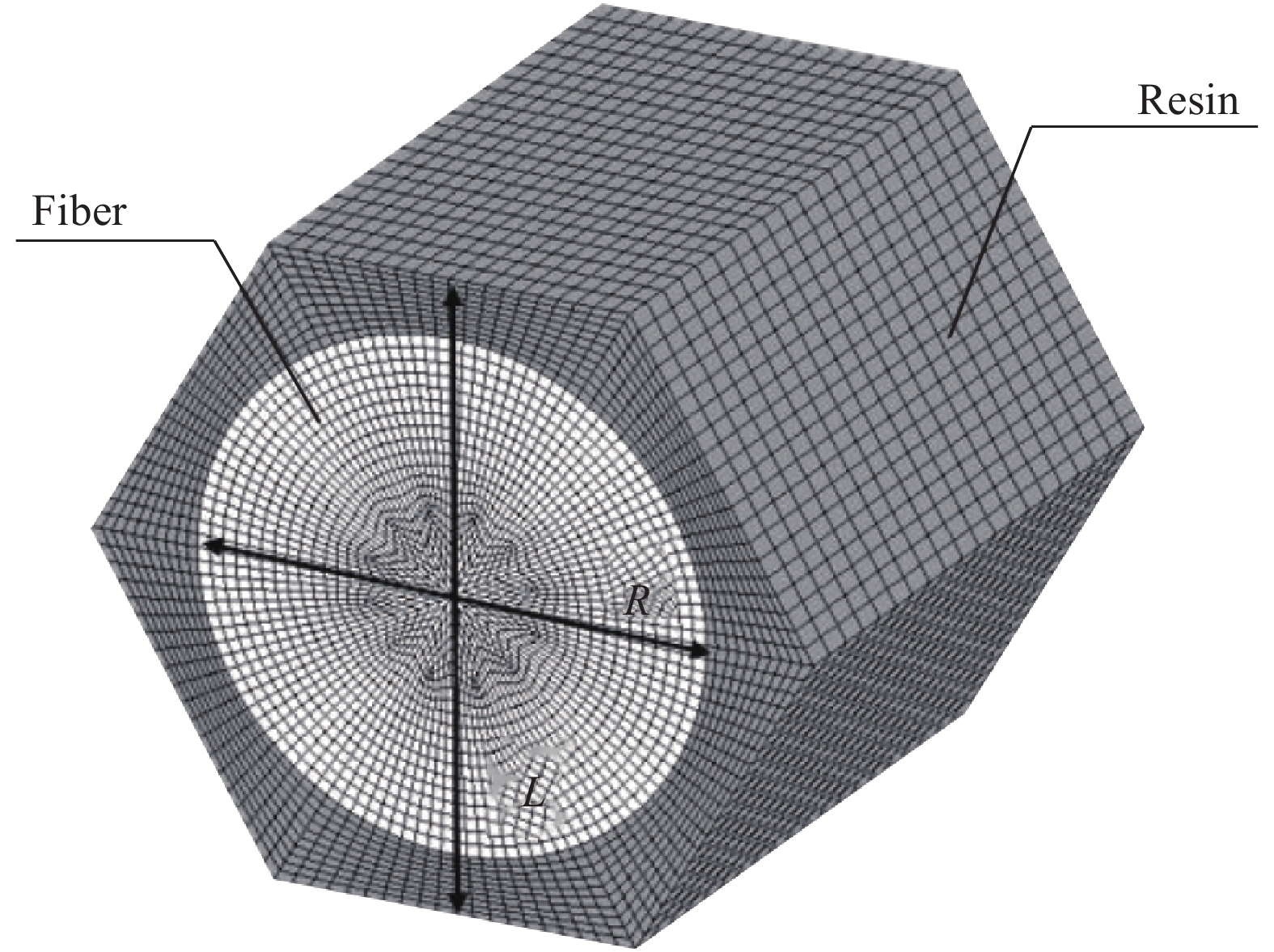Multiscale analysis and process parameters optimization of residual stress/strain of 3D woven composite
-
摘要: 为预测三维机织复合材料工艺引入的残余应力/应变,提出工艺制度优化方案,建立了一种工艺过程分析的多尺度模型。通过建立纤维尺度及纱线尺度代表体元(RVE),计算了成型过程中纤维纱线及三维机织复合材料的模量演化历程。考虑固化过程中树脂的化学收缩效应,在纱线尺度上开展热-化学-力学耦合分析,预测了细观残余应力-应变及其演化规律。采用三维机织技术,实现了光纤布拉格光栅传感器(FBG)在三维机织预制体中的预埋,并对其树脂传递模塑(RTM)成型过程中的温度、应变历程进行监测,试验结果验证了有限元模型的准确性。采用基于空间信息、误差信息和优化结果的三种序列采样方法,建立了工艺过程分析代理模型,并开展工艺参数优化设计,结果显示采用优化后的工艺参数,残余应变降低了15.4%,工艺周期缩短了10.6%。Abstract: To predict the process-induced residual stress/strain of 3D woven composite and propose the optimal cure cycle, a multiscale model of the process analysis has been developed. Based on the representative volume elements (RVE) at the fiber and yarn scale, the modulus development of yarns and 3D woven composite was obtained. A thermal-chemical-mechanical coupling analysis was conducted on the yarn scale with the consideration of chemical shrinkage effect of resin, and the evolution of the microscopic stress-strain was calculated. The fiber Bragg grating (FBG) sensors were embedded in the 3D woven preform through the 3D weaving technique, and the evolutions of temperature and strain were monitored. The accuracy of the finite element model was validated by the experimental result. Three sequential sampling methods based on space, error and result were adopted to establish the surrogate model of the process analysis of 3D woven composite. Based on the surrogate model, the optimization of process parameters of 3D woven composite forming process was carried out. The results show that the residual strain is reduced by 15.4% and the cure cycle is shortened by 10.6%.
-
Key words:
- 3D woven composite /
- multiscale /
- residual stress /
- surrogate model /
- optimization design
-
Parameter Value ${\rho _{\rm{r}}}/({\rm{kg}} \cdot {{\rm{m}}^{ - 3}})$ $90\alpha + 1\;232(\alpha \leqslant 0.45)\ \ \ \ 1\;272(\alpha > 0.45)$ ${C_{\rm{r}}}/({\rm{J}} \cdot {{\rm{(kg}} \cdot {\rm{K)}}^{ - 1}})$ $4\;148(0.468 + 5.975 \times {10^{ - 4} }T - 0.141\alpha )$ ${k_{\rm{r}}}/({\rm{W}} \cdot {{\rm{(m}} \cdot {\rm{K)}}^{ - 1}})$ $0.04184(3.85 + (0.035T - 0.141)\alpha )$ ${H_{\rm{r}}}/\left( {{\rm{J}} \cdot {\rm{k}}{{\rm{g}}^{ - 1}}} \right)$ $473\;600$ ${A_1}/{\min ^{ - 1}}$ $2.102 \times {10^9}$ ${A_2}/{\min ^{ - 1}}$ $ - 2.104 \times {10^9}$ ${A_3}/{\min ^{ - 1}}$ $1.960 \times {10^5}$ $\Delta {E_1}/\left( {{\rm{J}} \cdot {\rm{mo}}{{\rm{l}}^{ - 1}}} \right)$ $8.07 \times {10^4}$ $\Delta {E_2}/\left( {{\rm{J}} \cdot {\rm{mo}}{{\rm{l}}^{ - 1}}} \right)$ $7.78 \times {10^4}$ $\Delta {E_3}/\left( {{\rm{J}} \cdot {\rm{mo}}{{\rm{l}}^{ - 1}}} \right)$ $5.66 \times {10^4}$ Notes: ${\rho _{\rm{r}}}$—Density of the resin; ${C_{\rm{r}}}$—Specific heat capacity of the resin; ${k_{\rm{r}}}$—Thermal conductivity of the resin; Ai—Frequency factors; $\Delta {E_i}$—Activation energies. 表 2 AS4碳纤维和3501-6环氧树脂力学性能[10]
Table 2. Mechanical properties of AS4 carbon fiber and 3501-6 epoxy resin[10]
Parameter Value $E_{\rm{r}}^\infty /{\rm{GPa}}$ 3.447 $E_{\rm{r}}^0/{\rm{GPa}}$ 3.447/1 000 $v_{\rm{r}}^\infty $ 0.37 ${\phi _{\rm{r}}}/℃{^{ - 1}} $ $57.6 \times {10^{ - 6}}$ ${E_{{\rm{f}}1}}/{\rm{GPa}}$ 206.8 ${E_{{\rm{f}}2}}/{\rm{GPa}}$ 20.7 ${v_{{\rm{f}}12}}$ 0.2 ${v_{{\rm{f}}13}}$ 0.2 ${v_{{\rm{f}}23}}$ 0.5 ${G_{{\rm{f}}12}}/{\rm{GPa}}$ 27.6 ${G_{{\rm{f}}13}}/{\rm{GPa}}$ 27.6 ${G_{{\rm{f}}23}}/{\rm{GPa}}$ 6.9 ${\phi _{{\rm{f}}1}}/℃{^{ - 1}}$ $ - 9.0 \times {10^{ - 7}}$ ${\phi _{{\rm{f}}2}}/℃{^{ - 1}}$ $7.2 \times {10^{ - 6}}$ Notes: E, v and G—Elastic modulus, Poisson’s ratio and shear modulus, respectively; $\phi $—Coefficient of thermal expansion; subscripts f and r represent fiber and resin respectively. Parameter Value ${\rho _{\rm{f}}}/\left( {{\rm{kg}} \cdot {{\rm{m}}^{{\rm{ - 3}}}}} \right)$ 1790 ${C_{\rm{f}}}/\left( {{\rm{J}} \cdot {{\left( {{\rm{kg}} \cdot {\rm{K}}} \right)}^{ - 1}}} \right)$ $750 + 2.05T$ $k_{\rm{f}}^{\rm{L}}/\left( {{\rm{W}} \cdot {{\left( {{\rm{m}} \cdot {\rm{K}}} \right)}^{ - 1}}} \right)$ $ 0.04184 \times \left( {3.85 + \left( {0.035T - 0.141} \right)\alpha } \right) $ $k_{\rm{f}}^{\rm{T}}/\left( {{\rm{W}} \cdot {{\left( {{\rm{m}} \cdot {\rm{K}}} \right)}^{ - 1}}} \right)$ $2.4 + 0.00507T$ Notes: ${\rho _{\rm{f}}}$—Density of the fiber; ${C_{\rm{f}}}$—Specific heat capacity of the fiber; $k_{\rm{f}}^{\rm{L}}$, $k_{\rm{f}}^{\rm{T}}$—Longitudinal and transverse thermal conductivity of the fiber respectively. 表 4 多岛遗传优化算法参数
Table 4. Parameters used for multi-island GA optimization
Parameter Value Number of generations 50 Number of islands 2 Rate of migration 0.25 Rate of mutation 0.01 Sub-population size 100 Elite size 2 表 5 三维机织复合材料固化工艺参数优化结果
Table 5. Optimized results of process parameters for 3D woven composite curing
Parameter Original value Optimal value h1 /(℃·min−1) 2 2.038 h2 /(℃·min−1) 2 1.794 c1 /(℃·min−1) 2 3.88 ${t_{{\rm{cc}}}}$/min 340 303.7 ${\bar \varepsilon _{{\textit{zz}}}}\left( x \right)$/10−6 −1 089 −921.2 -
[1] 周储伟, 张音旋. 三维机织复合材料多尺度黏弹性分析[J]. 复合材料学报, 2007, 24(5):125-129. doi: 10.3321/j.issn:1000-3851.2007.05.023ZHOU Chuwei, ZHANG Yinxuan. Multi-scale viscoelastic analysis of 3D woven composite materials[J]. Acta Materiae Compositae Sinica,2007,24(5):125-129(in Chinese). doi: 10.3321/j.issn:1000-3851.2007.05.023 [2] 杨彩云, 李嘉禄. 三维机织复合材料力学性能的各向异性[J]. 复合材料学报, 2006, 23(2):59-64. doi: 10.3321/j.issn:1000-3851.2006.02.011YANG Caiyun, LI Jialu. Mechanical anisotropy of three dimensional woven composites[J]. Acta Materiae Compositae Sinica,2006,23(2):59-64(in Chinese). doi: 10.3321/j.issn:1000-3851.2006.02.011 [3] 周光明, 王新峰, 王鑫伟, 等. 三维机织复合材料的力学模型与实验验证[J]. 南京航空航天大学学报, 2004, 36(4):444-448.ZHOU Guangming, WANG Xinfeng, WANG Xinwei, et al. Mechanical model and experimental verifications of 3D woven composites[J]. Journal of Nanjing University of Aeronautics & Astronautics,2004,36(4):444-448(in Chinese). [4] WANG Q, LI T, YANG X, et al. Multiscale numerical and experimental investigation into the evolution of process-induced residual strain/stress in 3D woven composite[J]. Composites Part A: Applied Science and Manufacturing,2020,135:105913. [5] 郭兆璞, 陈浩然, 息志臣. 复合材料层合板的固化残余应力和变形分析[J]. 复合材料学报, 1996, 13(1):105-110.GUO Zhaopu, CHEN Haoran, XI Zhichen. Analysis of residual stress and deformation of composite laminates[J]. Acta Materiae Compositae Sinica,1996,13(1):105-110(in Chinese). [6] 张江涛, 尚云东, 张梅, 等. 复合材料固化相关黏弹性性能演化及残余应力分析[J]. 复合材料学报, 2017, 34(5):978-986.ZHANG Jiangtao, SHANG Yundong, ZHANG Mei, et al. Analysis on the process dependent viscoelastic properties and residual stresses of composites during cure[J]. Acta Materiae Compositae Sinica,2017,34(5):978-986(in Chinese). [7] JOHNSTON A A. An integrated model of the development of process-induced deformation in autoclave processing of composite structures[D]. Vancouver: University of British Columbia, 1997. [8] 丁安心. 热固性树脂基复合材料固化变形数值模拟和理论研究[D]. 武汉: 武汉理工大学, 2016.DING Anxin. Numerical and theoretical study on process-induced[D]. Wuhan: Wuhan University of Technology, 2016(in Chinese). [9] STANGO R J, WANG S S. Process-induced residual thermal stresses in advanced fiber-reinforced composite laminates[J]. Journal of Engineering for Industry,1984,106(1):48-54. doi: 10.1115/1.3185910 [10] BOGETTI T A, GILLESPIE J W. Process-induced stress and deformation in thick-section thermoset composite laminates[J]. Journal of Composite Materials,1992,26(5):626-660. doi: 10.1177/002199839202600502 [11] BENAVENTE M, MARCIN L, COURTOIS A, et al. Numerical analysis of viscoelastic process-induced residual distortions during manufacturing and post-curing[J]. Composites Part A: Applied Science and Manufacturing,2018,107:205-216. doi: 10.1016/j.compositesa.2018.01.005 [12] TWIGG G, POURSTARTIP A, FERNLUND G. Too-part interaction in composites processing. Part II: numerical modelling[J]. Composites Part A (Applied Science and Manufacturing),2004,35(1):0-141. [13] BARAN I, HATTEL J H, AKKERMAN R. Investigation of process induced warpage for pultrusion of a rectangular hollow profile[J]. Composites Part B: Engineering,2015,68:365-374. doi: 10.1016/j.compositesb.2014.07.032 [14] ZOBEIRY N, VAZIRI R, POURSARTIP A. Computationally efficient pseudo-viscoelastic models for evaluation of residual stresses in thermoset polymer composites during cure[J]. Composites Part A: Applied Science and Manufacturing,2010,41(2):247-256. [15] DING A, LI S, SUN J, et al. A comparison of process-induced residual stresses and distortions in composite structures with different constitutive laws[J]. Journal of Reinforced Plastics and Composites,2016,35(10):807-823. doi: 10.1177/0731684416629764 [16] PRASATYA P, MCKENNA G B, SIMON S L. A viscoelastic model for predicting isotropic residual stresses in thermosetting materials: Effects of processing parameters[J]. Journal of Composite Materials,2001,35(10):826-848. doi: 10.1177/a037322 [17] ROSSO P, FIEDLER B, FRIEDRICH K, et al. The influence of residual stresses implicated via cure volume shrinkage on CF/VEUH—composites[J]. Journal of Materials Science,2006,41(2):383-388. doi: 10.1007/s10853-005-2619-y [18] 李冬娜. 树脂基复合材料固化行为的多尺度仿真研究[D]. 兰州: 兰州理工大学, 2018.LI Dongna. Multiscale simulation investigation of curing behavior in resin matrix composites[D]. Lanzhou: Lanzhou University of Technology, 2018(in Chinese). [19] YUAN Z, WANG Y, YANG G, et al. Evolution of curing residual stresses in composite using multi-scale method[J]. Composites Part B: Engineering,2018,155:49-61. doi: 10.1016/j.compositesb.2018.08.012 [20] 徐胜利, 刘海涛, 王晓放, 等. 基于序列采样算法的轮盘减质优化[J]. 航空动力学报, 2014, 29(9):2097-2103.XU Shengli, LIU Haitao, WANG Xiaofang, et al. Mass optimization of turbine disk based on sequential sampling algorithm[J]. Journal of Aerospace Power,2014,29(9):2097-2103(in Chinese). [21] 殷艺云, 郭海丁. 基于粒子群神经网络的轮盘优化[J]. 航空动力学报, 2007, 22(9):1578-1582. doi: 10.3969/j.issn.1000-8055.2007.09.031YIN Yiyun, GUO Haiding. Optimization of turbine disk based on particle swarm optimization and neural network[J]. Journal of Aerospace Power,2007,22(9):1578-1582(in Chinese). doi: 10.3969/j.issn.1000-8055.2007.09.031 [22] 黄章俊, 王成恩. 基于Kriging模型的涡轮盘优化设计方法[J]. 计算机集成制造系统, 2010, 16(5):905-911.HUANG Zhangjun, WANG Cheng'en. Turbine discs optimization design based on Kriging model[J]. Computer Integrated Manufacturing Systems,2010,16(5):905-911(in Chinese). [23] 李铁柱, 李光耀, 陈涛, 等. 基于Kriging近似模型的汽车乘员约束系统稳健性设计[J]. 机械工程学报, 2010, 46(22):123-129. doi: 10.3901/JME.2010.22.123LI Tiezhu, LI Guangyao, CHEN Tao, et al. Robustness design of occupant restraint system based on Kriging model[J]. Journal of Mechanical Engineering,2010,46(22):123-129(in Chinese). doi: 10.3901/JME.2010.22.123 [24] REN M, WANG Q, CONG J, et al. Study of one-dimensional cure simulation applicable conditions for thick laminates and its comparison with three-dimensional simulation[J]. Science and Engineering of Composite Materials,2018,25(6):1197-1204. doi: 10.1515/secm-2017-0244 [25] HUANG C, REN M F, LI T, et al. Trans-scale modeling framework for failure analysis of cryogenic composite tanks[J]. Composites Part B: Engineering,2016,85:41-49. doi: 10.1016/j.compositesb.2015.09.023 [26] SHIN D D, HAHN H T. Compaction of thick composites: Simulation and experiment[J]. Polymer Composites,2004,25(1):49-59. doi: 10.1002/pc.20004 [27] LIU H, XU S, WANG X. Sequential sampling designs based on space reduction[J]. Engineering Optimization,2015,47(7):867-884. doi: 10.1080/0305215X.2014.928816 [28] 刘海涛. 基于近似模型的工程优化方法中相关问题研究及应用[D]. 大连: 大连理工大学, 2016.LIU Haitao. The research and application of metamodel-based engineering optimization[D]. Dalian: Dalian University of Technology, 2016(in Chinese). [29] WHITLEY D. A genetic algorithm tutorial[J]. Statistics & Computing,1994,4(2):65-85. -






 下载:
下载:



